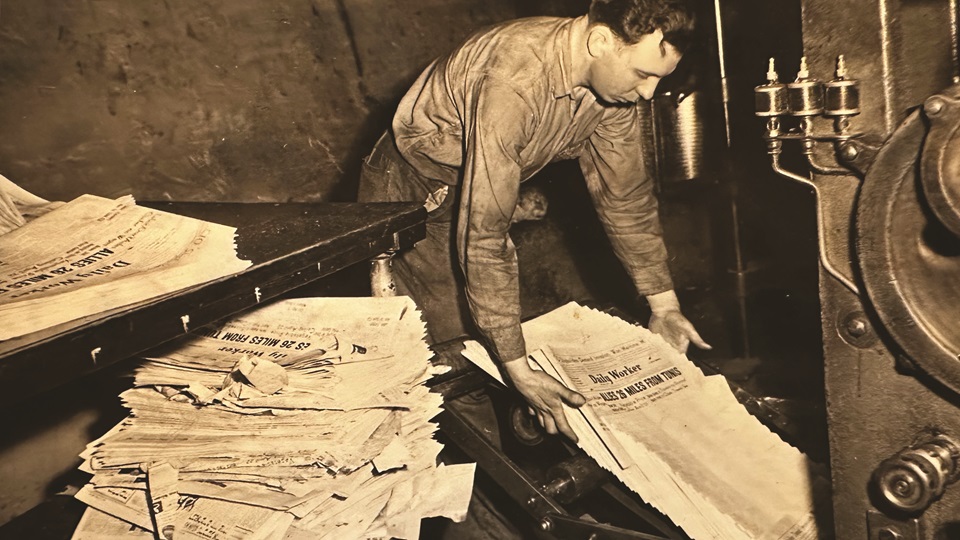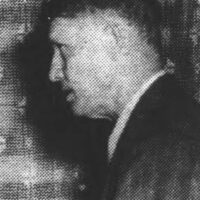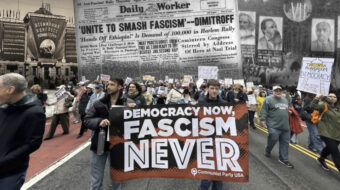
This article is part of the People’s World 100th Anniversary Series.
Art Shields (1898-1988), pioneering working class journalist, was present for the birth of People’s World—founded as the Daily Worker—in January 1924. In this article, assembled from reminiscences published in 1969 and 1974, he recalls those early days of the publication and the world into which it was born.
I got the best job of my life on Chicago’s North Side on a cold winter day in 1924. Other jobs have paid more, but none gave such satisfaction. And I wish I could relive the glad moment when the first copy of the Daily Worker came wet off the press.
The birth date was January 13, 1924. That’s a day I’ll never forget, as that’s the day the working class got a powerful weapon. It came smoking out of the Communist Party’s press and began striking heavy blows at the people’s enemies in its first issue.
And those enemies were all around. The national government was led by the “Ohio Gang,’’ sometimes called the “Oil Gang,” with Warren Harding, a bibulous, amoral politician in the White House; Harry Daugherty, a bribe-taker in the Attorney General’s office; Albert Fall of Teapot Dome oil infamy was the Secretary of the Interior; and there was Charles Evans Hughes, Standard Oil lawyer and Secretary of State.
They were servants of the real rulers—the Rockefellers, the Morgan bankers, the duPonts, and the Pittsburgh Mellons. On January 13, 1924, the national drive against labor was at its height. The unions had lost nearly half their members since the end of World War I. Big Business was bringing in what it called the “American Plan.” It took courage to fight these enemies—in Chicago especially.
In Chicago, the smells from the meat-packing houses of Armour and Swift, the smoke from the South Side mills of the U.S. Steel Corporation, the clatter of machinery from the giant Western Electric works in Cicero came from open shop plants where workers were fired if they uttered the word “union.”
In Chicago also, the Daily Worker was menaced by gangsters. A bullet fired by one underworld thug just missed the head of our circulation manager, Jack McCarthy, when he dared to challenge the big newsboys at the Chicago Tribune and Hearst.
This city, where our paper began its work, was the headquarters of this country’s most powerful gang lord. That was Al Capone, who railed against “red literature.”
Capone was a busy man. He ran the beer racket during Prohibition. He sold millions of bottles of bootleg whisky. He helped crooked politicians steal elections. He broke strikes. He ran gambling halls and houses of prostitution and murdered many men. Nevertheless, he once found time to say this for our publication: “Bolshevism is knocking at our gates…. We have got to organize against it… We must keep the worker away from red literature.”
By “red literature,” Capone meant this country’s only daily working-class paper in the English language. He meant the paper that was demanding peace and friendship with the Soviet Union—the paper that was working for a socialist world without gangsters or other exploiters. That was the Daily Worker.
But gangsters couldn’t stop us. The Daily Worker reached the people by shop gate and neighborhood sales and by letter carrier. Every morning, two Lithuanian comrades were at the Armour and Swift gates in the Packingtown jungle with bundles of Daily Workers. And it was a joy to see the bundles disappear into the hands of stockyard laborers and transport workers.
From time to time, I also watched U.S. Steel workers grabbing our paper at the big mill on the South Side. They gave their two cents—the price in those days—to a young Jewish comrade, who never failed to be there.
These cases were typical. The districts of the Communist Party, without exception, mobilized their members to distribute our paper. And no Daily Worker reporter who visited a union hall or a picket line did his job unless his paper was with him.
READ MORE: People’s World 100th Anniversary
I remember how the pickets in a Ladies Garment strike followed our stories day by day. I lived with that strike for weeks. I watched the cops slug and arrest the girls daily and was arrested myself. But the pickets held the line. And they read the Daily Worker at coffee breaks.
I deserve no credit for this strike-time circulation. It was handled by Dora Lifshitz, a dedicated Communist and skilled garment worker. Dora was the strikers’ field leader. She had been expelled from the International Ladies Garment Workers by right-wingers some time before. But International Vice President Meyer Perlstein, a right-winger, was desperate. His biggest Chicago local union faced defeat. The strikers clamored for Dora, and Perlstein caved in. He let her lead the picket lines and he bought a hundred Workers daily. “They help morale,” he told me.

Morale was so high that one cop almost went into the Chicago River. He made the mistake of slugging Laura, a striker, who was strong as a weightlifter. She almost had him over the bridge rail when he was rescued.
Our paper’s main enemies were always the big capitalists and their government agents. We directed our main fire against them. But the class struggle also went on inside the labor movement. The false concept of “Labor Capitalism” was put forward by top union bureaucrats. The Brotherhood of Locomotive Engineers, for instance, was running three non-union coal mines in West Virginia.
And William Z. Foster, the finest labor organizer in U.S. history, and his able co-worker, Jack Johnstone, fought for a clear class line at all meetings of the Chicago Federation of Labor that I attended. A number of other Communist delegates fought alongside them.
I met wonderful comrades in Chicago in 1924 through the Daily Worker. Among them was Robert Minor, the brilliant artist and speaker, who had led the drive that saved the life of Tom Mooney.
“Bob” Minor was giving nearly all his time to the struggles of the Black people on the South Side. And together we covered the first big national conference of African-American organizations. It was called “The Sanhedrin.”
Every Black organization, regardless of its politics, was invited to the Sanhedrin. There were clergymen, trade unionists, professors, and representatives of the tiny “Black bourgeoisie.” And there I met Otto Huiswoud and other Communist members of a left-wing organization, “The African Blood Brotherhood.” Its speakers urged delegates not to be used by reactionary white politicians, and they emphasized the fight against lynchings.
This paper also helped to change U.S. history. I saw this happen during the titanic union organizing drives in the major industries in the 1930s. I witnessed, for example, the historic steel drive that unionized the biggest heavy industry in the U.S. and brought some democracy into closed company towns. And these facts are as clear as the noonday sun: Sixty Communist Party members were the core of the official organizing staff that enrolled hundreds of thousands of union members. And the Daily Worker was the campaign’s chief propaganda weapon.
Our paper is one of the few fighting friends of labor in the English language daily press. I often look back fondly at the day our paper was founded. I’m one of two survivors of the writers who put out that first issue. But more men and women who made that issue possible are still around.
Our paper was built with the dollars of American workers. And the paper was distributed by workers who took it into the shops with them. Our paper comes from the people, is for the people, and is made by the people.
We hope you appreciated this article. At People’s World, we believe news and information should be free and accessible to all, but we need your help. Our journalism is free of corporate influence and paywalls because we are totally reader-supported. Only you, our readers and supporters, make this possible. If you enjoy reading People’s World and the stories we bring you, please support our work by donating or becoming a monthly sustainer today. Thank you!










